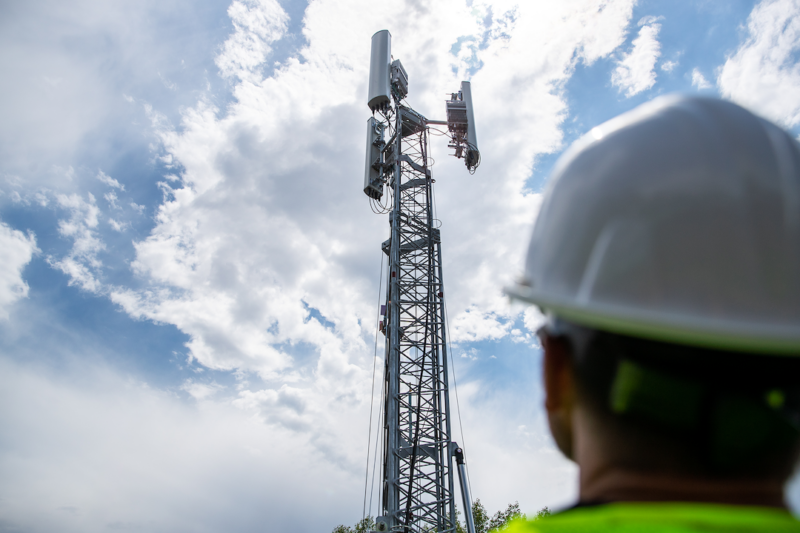Latest News

Dish Wireless is building the Dish 5G Open RAN network. Executives pitched the value of converging satellite and terrestrial technologies with the Dish EchoStar combination on Aug. 8, 2023. Photo: Dish
EchoStar Corporation and Dish Network are getting back together. The two Charlie Ergen-founded companies announced a deal to combine on Tuesday, with a plan to bring together satellite and terrestrial technologies to gain an advantage in the 5G ecosystem.
“By integrating Dish spectrum with EchoStar’s technological capabilities, we will have the ability to amplify 5G private networks. What we’re able to do is combine satellite communication and terrestrial communications, all within a 5G cloud native platform,” Ergen said Tuesday, detailing the opportunity of the combination to investors.
Under the terms of the deal, EchoStar shareholders will receive 2.85 shares of Dish Network stock for each share of EchoStar stock, at a premium of 12.9% to EchoStar stockholders. After the merger, Dish shareholders will own approximately 69% of the company and EchoStar shareholders will own approximately 31%. The transaction is expected to close in the fourth quarter.
EchoStar CEO Hamid Akhavan will serve as president and CEO of the combined company and Charles Ergen will serve as executive chairman. The combined company will be headquartered in Englewood, Colorado, maintaining its presence in Maryland with Hughes Network Systems.
The combined company has a number of customer brands with about 18 million total combined subscribers, including Dish Wireless, Boost Wireless, Sling TV and DISH TV, EchoStar, Hughes and Jupiter satellite services, HughesON managed services and HughesNet satellite internet.
A brief history lesson — Ergen founded EchoStar in 1980 as a satellite TV distributor. EchoStar developed the Dish Network brand, which was spun out in 2008. EchoStar then acquired Hughes Communications in 2011. Then in 2019, EchoStar sold off the satellite broadcast business to Dish in 2019, including its nine satellites. Meanwhile, Dish entered the U.S. market as the fourth wireless., acquiring some of Sprint’s business, with plans to build a 5G network. Now, Dish says that network covers more than 70% of the U.S. and its commercialization is underway.
“Bring together dishes enormously valuable portfolio of nationwide a spectrum built for private networks, and EchoStar decades of network experience and deep history of SD-WAN site management, we will be able to provide a more attractive and higher quality offering to capitalize on the significant 5G private network opportunity,” Akhavan said.
Akhavan said the companies see $75 million in OpEx and CapEx synergies, 75% of which can be achieved in the next two years. The combined company is also targeting 275 million in revenue synergies that will result in incremental $80 million in EBITDA by 2027 from opportunities in a combined 5G satellite broadband private network, expanded government services, and EchoStar enterprise relationships, he said.
He further detailed the opportunity for synergies in the enterprise business, pointing to Hughes Network Systems’ $400 million enterprise business. Akhavan said Hughes has demonstrated a private 5G network for the U.S. Navy at Whidbey Island in Washington state, utilizing spectrum and network core from Dish. “We are hoping that this is the foundation for many enterprise 5G and government 5G deployments.”
Another key opportunity down the line is the value of consolidating S-band spectrum holdings, with an eye toward direct-to-device service, Ergen said. EchoStar has publicly been exploring plans to build a global Low-Earth Orbit (LEO) satellite 5G network in the S-band.
Ergen pointed to the fact that Dish has North American S-band spectrum, and EchoStar has international S-band spectrum, which could present an easy path to collaborate on satellite direct-to-device with modem manufacturers, handset manufacturers, and operators.
“We’ll be in a unique position to potentially take advantage of that … If there’s a desire on the parts of operators, handset manufacturers, chip manufacturers, and government entities, we have it all together in a unique way that nobody else in the world does,” Ergen said.
“It is difficult to combine satellite and telco together. But our open architecture that we designed, was designed to put a satellite component into it. We thought about this a long time. We’re better off today together than we were before in terms of pursuing any opportunities there,” he added. “But it’s a long way off and it is not in our model. If you’re an investor looking out five years, you might be interested. But if you’re here today for quarter-to-quarter, it’s not in our model.”
Stay connected and get ahead with the leading source of industry intel!
Subscribe Now